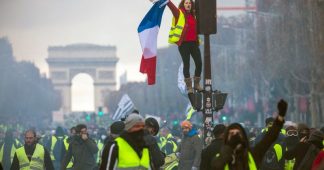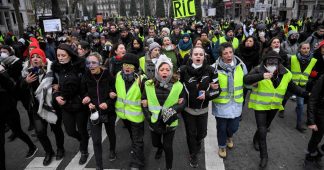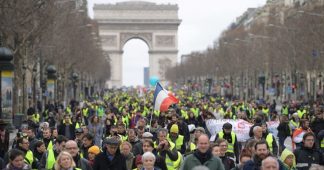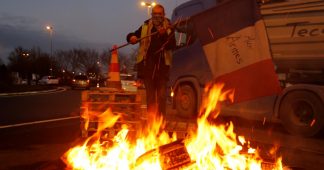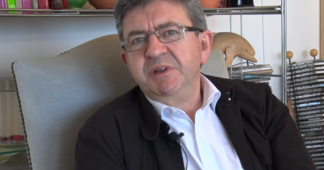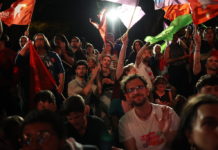21 March 2019
When they gathered at roads and roundabouts at the end of last year, the French government was caught off guard. Within a week of their first nationwide mobilisation, they were turning out regularly at intersections across the country to slow up traffic, and marching through Paris and the big provincial cities. Hasty polls announced that 70 or 80 per cent of the population, including many in France’s largest conurbations, supported this massive show of impatience. Yet the gilets jaunes first came together beyond the margins of the major cities, in rural areas and small towns with rundown services, low-wage economies and dwindling commerce. They were suspicious of the burgeoning metropolitan areas, which have done well on a diet of public funding, private investment, tourism and succulent property prices. Among them are people who grew up in city centres but can no longer afford to live in them: these barbarians know where they are when they arrive at the gates. Parading in central Paris and the new, carefully massaged hubs of French prosperity – Toulouse and Bordeaux especially – they end proceedings with a show of violence and destruction. After 15 weeks of costly protest, public sympathy in the big metropolitan areas has only recently begun to fall off. That is one of many puzzles.
Another is the pace at which a provincial revolt about fuel prices and speed limits broadened into a radical rejection of Macron, the office he holds, the National Assembly and the political parties, including Marine Le Pen’s Rassemblement National – formerly the Front National – and Jean-Luc Mélenchon’s La France Insoumise. State expenditure and tax rates for rich and poor alike were also called into question: public services in the hinterlands (schools, doctors’ surgeries, childcare, care for the elderly, job creation) and local government institutions were felt to be poorly resourced and staffed, while cities flourished as immense enclaves of prosperity.
On 17 November last year, a Saturday, a motorcade of bikes and cars swept down the grands boulevards in Paris. The bikers were wearing yellow hi-vis vests; you could see them in the cars as well, placed ostentatiously on the dashboard. The procession passed in less than two minutes. I was watching with a journalist from France 24, the state’s international television network, who gave a derisive shrug. But 280,000 gilets jaunes were out across France, creating go-slows at roundabouts, motorway tolls and intersections. It was a triumph; they were ready for more. On their Facebook pages they began referring to 17 November as ‘Act I’.
I’d already been stopped that morning at a roundabout not far from where I live in south-west France. A small group of gilets jaunes were blocking the road, complaining first about the cost of fuel, then the cost of living, then of having to scrape by on low-paid work with nothing in hand at the end of the month, then of Macron. One called him ‘le roi Macron’: she wanted his head to roll. They were playful and serious by turns and they had a plausible case. It didn’t cross my mind that two months later, after round upon round of violent demonstrations in France’s major cities, I’d be with a group of protesters – many in their late sixties – caught between two baton charges by riot police in central Bordeaux, watching young men with jemmies prising the thick plywood panels from a bank which had taken the trouble to seal off its glass front. Or look on as a demonstrator with an aerosol can sprayed an 18th-century monument with a tweaked version of a line from the ‘Internationale’. On one venerable limestone column he wrote: ‘Nous sommes rien.’ On the other: ‘Nous voulons tout.’ Rapturous applause from a crowd of thousands.
Bordeaux is a paragon of France’s spick-and-span ‘metropoles’, with their impoverished hinterlands. The press has described it as ‘the capital of the gilets jaunes’. After ‘Act II’ on 24 November the weekly protests in the city were well attended, with six or seven thousand participants at their height. The demonstrations were rowdy, carnivalesque, occasionally provocative, but they usually unfolded peaceably for most of the afternoon. Around dusk, groups of demonstrators would take the fight to the police while others left for home.
These outings have ritual echoes from a long past of French contestation, but the gilets jaunes who converge on the big towns on Saturdays are thoroughly 21st-century citizens, left out in the cold by globalisation. The success of their protest depends on social media. They mobilise and reach last-minute decisions mainly on Facebook. They position themselves theatrically: giving every Saturday ‘act’ a number commits them – and everyone watching – to a weekly cliffhanger, in the style of a serial podcast or reality TV show. About one in four demonstrators in Paris, where I last tried to count (in early February), had their smartphones up, recording as they marched, chanted or struggled through a haze of tear gas. Demonstrations are produced and curated as they unfold, becoming a series of ‘scenes from a demonstration’, with hundreds of director/participants live-streaming or waiting to upload content from their phones at the end of the day.
Among this vast reservoir of images is material that can be useful when demonstrators challenge the police account of a fight or an injury. And there is another distinguishing feature of the gilet jaune marches: half a century after 1968, the French police are equipped with far more dangerous ‘non-lethal’ technology, including dispersion and tear-gas grenades and a kind of ‘flash-ball’, or rubber bullet, discharged from a handheld launcher. Since Act II, ‘deterrent’ weapons in the hands of the police have produced hundreds of serious injuries, though remarkably only one death – an elderly woman in Marseille who had nothing to do with the demonstrators. By contrast, several gilets jaunes have been killed in traffic incidents during go-slows and blockades on the roads.
The roads, of course, are where the story of the gilets jaunes began, more than a year ago, when the government proposed to reduce the speed limit from 90 to 80 kph on 400,000 kilometres of single carriageway in France. In the Dordogne an ‘anger’ group, which had mustered on Facebook, took to the streets of Périgueux calling for the plan to be scrapped. In other rural departments similar anger groups were on the rise. Some of the protesters wore hi-vis jackets (French law states that drivers have to have them in their vehicles). No one was calling them gilets jaunes at that stage, but the protests seemed to be the start of a focused movement with a central demand. Another demand was added last summer, when Priscillia Ludosky, a young entrepreneur with a small-scale cosmetics business, launched a petition on change.org calling for a reduction in petrol prices. Ludosky works in a built-up, peri-urban landscape (beyond the capital and the banlieues), where car travel is a necessity. She’s also a perfect fit for Macron’s vision of a new, striving France full of initiative-takers from all walks of life, including minorities: a thirty-something black Frenchwoman. By the autumn her petition was edging forward with 12,000 signatures. Then in October Jacline Mouraud, a talkative, eccentric figure from Brittany – accordionist, ectoplasm hunter and hypnotherapist – posted a video on Facebook in which she denounced the tax burden on motorists, along with speeding fines, as systematic pillage. The 80 kph law had been in force since July and dissident drivers were already destroying speed cameras. Fuel tax had risen significantly since 2017 and was set to rise again by nearly 10 cents a litre for petrol and 19 for diesel by 2022 as part of a plan to achieve an ‘ecological transition’ away from fossil fuels. Before long the number of visits to Mouraud’s Facebook page reached six million and signatures on Ludosky’s petition passed the one million mark. Eric Drouet, a lorry driver in his thirties, went on Facebook to call for a mass blockade of the roads; the call spread; similar posts appeared on other Facebook pages. Wherever you went, drivers had a hi-vis jacket on the dashboard, to signal their allegiance, or their sympathy, or as a passport through go-slows.
The success of Act I must have surprised the gilets jaunes as much as it did the rest of the country. Over the next few days a leaderless movement with a handful of social media figureheads (Drouet, Ludosky and others) became a leaderless revolt against the president, the government, high taxes and low pay. The following Saturday in Paris – Act II – a crowd of thousands did their best to ransack the Champs Elysées, raising barricades, setting them alight and smashing shopfronts. Five policemen and 19 demonstrators were injured in fierce clashes; hundreds of people were taken into custody. In the rest of France nearly 160,000 gilets jaunes came out to protest. The executive was in disarray: Macron had been trying to keep a ‘Jupiterian’ distance, while the prime minister, Edouard Philippe, and various members of his cabinet were shoved forward to condemn the violence and announce that there would be no change of position on fuel tax. But the gilets jaunes now had bigger, more nebulous ambitions than the price of fuel. The time had come for Macron to take to the airwaves. A few days after the fracas on the Champs Elysées he used a speech on energy and climate change to propose a floating tax on fuel pegged to the price of crude, as Lionel Jospin had done when he was prime minister in 2002.
But the gilets jaunes already had the tempo, and like many road users they were sceptical about talk of higher fuel prices in the context of reducing carbon emissions. France’s so-called ‘carbon tax’ is not a distinct component of the overall levy on fuel, so it’s impossible to know how the government will spend it. But even supposing it was a hypothecated tax, with revenues channelled to renewable energy etc, why should it be a flat levy on rich and poor alike? In the turmoil of the next two months, it became easy for their detractors to scorn the gilets jaunes as rural idiots addicted to fossil fuels. And just as easy for sympathetic commentators and green-left radicals, broadly supportive of the gilets jaunes, to call for an alignment of ‘environmental justice’ with social justice. What this meant wasn’t clear beyond the principle, which the government endorsed, that the state should ‘accompany’ less prosperous people – i.e. give them financial support – during the transition away from carbon. But increasing a universal tax on fuel proved that ‘accompanying’ poorer citizens wasn’t what it had in mind, even though in the EU – from Luxembourg, with the highest per capita carbon footprint, to Romania, with one of the lowest – prosperous consumers are far greater contributors to global warming than those with a smaller disposable income. Key questions of this kind – who pays for environmental jeopardy? – would hang just beyond the reach of the executive, the press, social media and even the gilets jaunes, once they were committed to a showdown with Macron. Dismissive of his offer to rethink the fuel tax, they were readying for Act III and a new steeliness had set in. There were probably 135,000 people on the streets (and the roads) the following Saturday, 1 December. There were also hundreds of injuries and arrests and a fatal accident at a go-slow. In Paris the Arc de Triomphe was vandalised. Astonishingly, public support appeared to hold up.
Macron and the government now had their backs to the wall. Philippe had tried to open a dialogue with the gilets jaunes ahead of Act III, but there were no leaders: he managed to collar a lone gilet jaune prepared to talk to him for an hour. After the impressive turn-out on 1 December he attempted to set up another meeting between a group of ‘spokespersons’ and the heads of France’s political parties, but it was scuppered when death threats were issued on social media to some of the gilets jaunes who had agreed to take part. Leaderlessness and horizontality were non-negotiable: a charismatic gilet jaune like Eric Drouet might surface and rally the troops, but that person could not speak directly to government on behalf of any other gilet jaune. If they’d believed in leaders, delegates and representatives, after all, the gilets jaunes might still have had faith in the National Assembly, the political parties and the unions.
Their suspicion of ‘mainstream’ media, TV news in particular, was also deepening (several journalists were attacked at subsequent demonstrations). The gilets jaunes spurned any narrative they weren’t in charge of, with thousands of hours of crowd-sourced uploads swelling their own radiant news bubble. They were the story and only they would tell it. This dislike of any mediation other than their own had a wild, hubristic edge: you got a sense from the slogans on the backs of their jackets and their social media posts that they would have liked to stride through any institution – from the fourth estate to the judiciary – which stood in the way of a face-to-face showdown with Macron. In a re-enactment of the women’s march on Versailles in 1789, le roi Macron would appear to the crowd and then retire from his balcony full of contrition. The crowd would then demand an audience with the queen. How much did the Sèvres dinner service Brigitte had commissioned for the Elysée Palace really cost? Was it €50,000, as palace officials claimed, or nearer €500,000, as Le Canard enchaîné had suggested? The crockery scandal had come at the same time as Macron’s ill-judged remarks about the ‘crazy amounts of dough’ draining into the benefits system.
* * *
In the first week of December the executive caved in on fuel tax. Philippe announced that the rise, due in January, would be put on hold for six months. The news was greeted with contempt by the gilets jaunes and the following day word came down from the president’s office that the fuel tax hike was no longer part of the 2019 budget. Even this was not enough. A list of 42 demands, addressed to MPs, was now circulating and you had to get to number nine before fuel taxes were mentioned. The origin of the document is unclear – perhaps one gilet jaune, or a group, in a department a couple of hours from Paris – but it was soon being reproduced in the press.
If there was antagonism from other gilets jaunes over the creation of this list of ‘People’s Directives’, at least there were no death threats. The document began with a demand for ‘zero homelessness’ and ended with a call for taxes on aviation and maritime fuel. There was a call for a ‘popular referendum’ mechanism, allowing laws to be proposed by citizens: if a proposal garnered 700,000 signatures it would go before the National Assembly and a final version would be put to the electorate. Variants of this idea were already doing the rounds: once it crystallised into a demand, known as the ‘Référendum d’initiative citoyenne’, you began to see the letters ‘RIC’ on hi-vis jackets and signs at demonstrations. The RIC would also enable the repeal of laws, moot changes to the constitution, and approve or vote down international treaties: imagine the response to a new transatlantic trade treaty modelled on the TTIP.
The People’s Directives were short on ideas about revenue for the Treasury, but long on wealth redistribution, protecting French industry, caring for the elderly, bolstering rent controls, raising the minimum wage and the minimum pension, and capping monthly salaries at €15,000: the earnings gap touches a raw nerve with the gilets jaunes. The luxury goods tycoon Bernard Arnault – Dior, Louis Vuitton, Givenchy, fine champagne and cognac – alleged by the weekly magazine Marianne to make €3 million an hour, has cropped up twice in my exchanges with activists, on one occasion with a volunteer medic tending demonstrators injured by the police. She told me she earned around €1100 a month from her job as a careworker for the elderly. That’s hard to live on in France, unless you have parental support or a partner in work. Quite a few gilets jaunes work in the care sector, and as the state opts for outsourced labour, or simply lets recruitment dwindle, they can find themselves on reduced earnings in the private sector, selling their skills via agencies, which take a cut from their wages.
Oddly, a key demand was missing from the list of 42, even though it was gaining traction at demonstrations and go-slows: the reintroduction of the wealth tax. Macron scrapped this ‘solidarity’ tax on the rich last year and replaced it with a tax on property worth more than €1.3 million. If France continued penalising equity, the argument ran, it would stimulate capital flight; better to target high-end real estate, whose value grew while its owners sat on it. But the gilets jaunes were not convinced: why humiliate low-wage earners, they asked, by rewarding the wealthy with a tax break? Neither was Thomas Piketty. On his blog for Le Monde he rejected Macron’s assertions about capital flight – ‘totally false’ – and showed that receipts from the tax on global wealth had increased fourfold during the previous three decades, even though the threshold at which French fortunes were liable had risen over the years. ‘A bas les priviliégés!’ was one of several anti-wealth slogans I saw on a hi-vis vest. The wearer was a tiny, tousle-haired woman in her late fifties, marching arm in arm with a tall, much younger blind man. Another: a lame, elderly man with two bright pink ski-poles and a slogan on his back calling for his pension to increase at the same rate as ‘share dividends’. A third: a youngster fifty metres from a police cordon spraying the front of an upmarket Bordeaux estate agent in silver lettering: ‘Coucou les riches!’ (‘Coucou’, as in hide-and-seek, means roughly: ‘I can see you!’)
